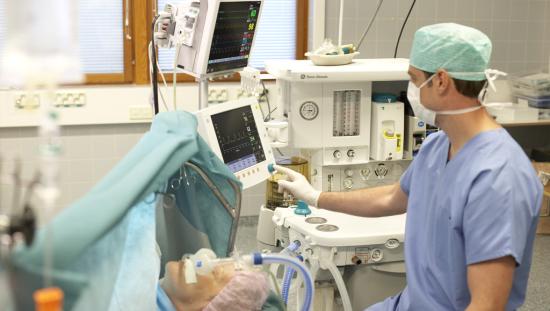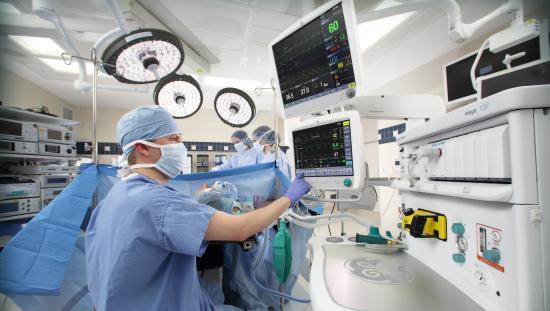
In the fight against climate change and greenhouse gas emissions, the focus tends to be on transportation and large-scale production facilities. Most people don’t think of healthcare services of having an impact on greenhouse gas emissions – but the truth is, healthcare services account for up to 5% of all greenhouse gas emissions1. To further illustrate how energy intensive healthcare is, healthcare services consume 8% of the total energy produced in the United States2.
Surgical procedures account for a large part of these emissions thanks to the high volume of resources used in both anesthesia and surgical care.1 This has led to research on both the impact on the environment and potential interventions that may improve the overall environmental footprint of anesthesia and surgical care. A 2021 literature review explored the climate impact of hospitals in the United States, the United Kingdom, and Canada.
Case studies were reviewed, and researchers concluded if these case studies were an accurate representation of the typical surgical suite in these areas – the yearly carbon footprint would be equal to that of two million vehicles.1
When it comes to reducing the environmental impact of anesthesia emissions, there are several options currently available and many more being explored for future use. Using low-impact gases like sevoflurane and using low-flow anesthesia when possible can help reduce greenhouse gas emissions in the operating room.
Sevoflurane Has a Lower Global Warming Impact
Nitrous oxide, desflurane, and isoflurane have the highest global warming potential based on studies from researchers at the Jet Propulsion Lab.2 When released into the environment, desflurane can live in the atmosphere for up to 14 years. This contributes to the depletion of the ozone layer and causes heat retention, which contributes to global warming.3 Studies have shown when there are disparities between hospitals and their greenhouse gas emissions, the biggest factor was the use of desflurane compared to other gases3.
On the other hand, Sevoflurane has a significantly lower impact on the atmosphere than desflurane, isoflurane and nitrous oxide.1 Rather than 14 years in the atmosphere, sevoflurane has a much shorter atmospheric life span of 1.1 years.3 When used for an hour of anesthesia, sevoflurane impacts global warming 26 times less than desflurane and 590% less impactful than nitrous oxide.3
Adopting Low Flow Practices to Reduce Waste
While using a closed circuit is the ideal method to reduce greenhouse gas emissions, this isn’t always possible or feasible in today’s operating room. Therefore, using low-flow anesthesia to reduce environmental impact is the most realistic intervention4.
While there is no standard guideline for low-flow practices, many experts consider low-flow anesthesia to consist of flow <1 L/min with the minimal flow being 0.5 L/min.4
Using low-flow anesthesia during all phases of anesthesia and turning fresh gas flow off (instead of the vaporizer) during intubation can reduce total gas emissions.2 Thanks to advances in anesthesia ventilator technology, modern anesthesia delivery systems can accommodate much lower fresh gas flow rates to both maximize gas recirculation and reduce any waste.2
Not only does a lower flow rate consume and emit less anesthetic gas, but it can also have an additional effect on the surgical suite environment by reducing overall temperature and humidity.3 This can lead to a secondary benefit of reduced central air and heating use, reducing energy expenditure and cost.
WFSA Global Consensus Statement
The World Federation of Societies of Anesthesiologists (WFSA) recently published a global consensus statement regarding environmentally sustainable anesthesia principles5. In addition to using medications that have a lower environmental impact when possible and minimizing waste – the WFSA addresses the need for hospital systems and organizations to develop tools to measure their carbon footprint and only purchase materials from manufacturers who are actively working to decrease their own footprint as well.5
There are recommendations surrounding the need for education regarding the impact of anesthesia services on the environment within the statement. This includes prioritizing environmentally sustainable training for clinicians and educating the local community.5
The WFSA supports mandates for healthcare organizations regarding emissions and recommends that countries work together to support each other in reducing greenhouse gas emissions, regardless of their economic status.5
While there is much to learn about the impact of healthcare services, thankfully there are plenty of interventions clinicians can start implementing to reduce the role anesthesia plays in greenhouse gas emissions.
Summary:
- In the fight against climate change, healthcare services must be considered due to the high consumption of energy and high levels of waste contributing to greenhouse gas emissions
- Sevoflurane should be the priority anesthetic agent used as it has a much lower environmental impact compared to other inhaled anesthetics
- Using low-flow anesthesia can reduce waste and reduce the amount of gas that can remain in the atmosphere for many years
- The recent WFSA statement provides several recommendations to reduce carbon footprint ranging from increasing education to implementing mandates to reduce emissions
References
[1] Drew, J et al. (2021). Operating in a Climate Crisis: A State-of-the-Science Review of Life Cycle Assessment within Surgical and Anesthetic Care. Environmental Health Perspectives. 129(7). 076001-1 – 076001-18.
[2] Ryan. S. (2012). Sustainable Anesthesia. International Anesthesia Research Society. 114(5). 921-923.
[3] Gaya da Costa, M.; Kalmar, A.F.; Struys, M.M.R.F. (2021). Inhaled Anesthetics: Environmental Role, Occupational Risk, and Clinical Use. J. Clin. Med. 10(1306). 1-22.
[4] Feldman, J. (2012). Managing Fresh Gas Flow to Reduce Environmental Contamination. Anesthesia & Analgesia. 114(5). 1093-1101.
[5] White, S et al (2021). Principles of environmentally-sustainable anesthesia: a global consensus statement from the world federation of societies of anesthesiologists. Anesthesia. 1-12.
© GE, 2021 – All rights reserved.
GE and the GE Monogram are trademarks of GE. Reproduction in any form is forbidden without prior written permission from GE. Nothing in this material should be used to diagnose or treat any disease or condition. Readers must consult a healthcare professional.
JB18645XX













